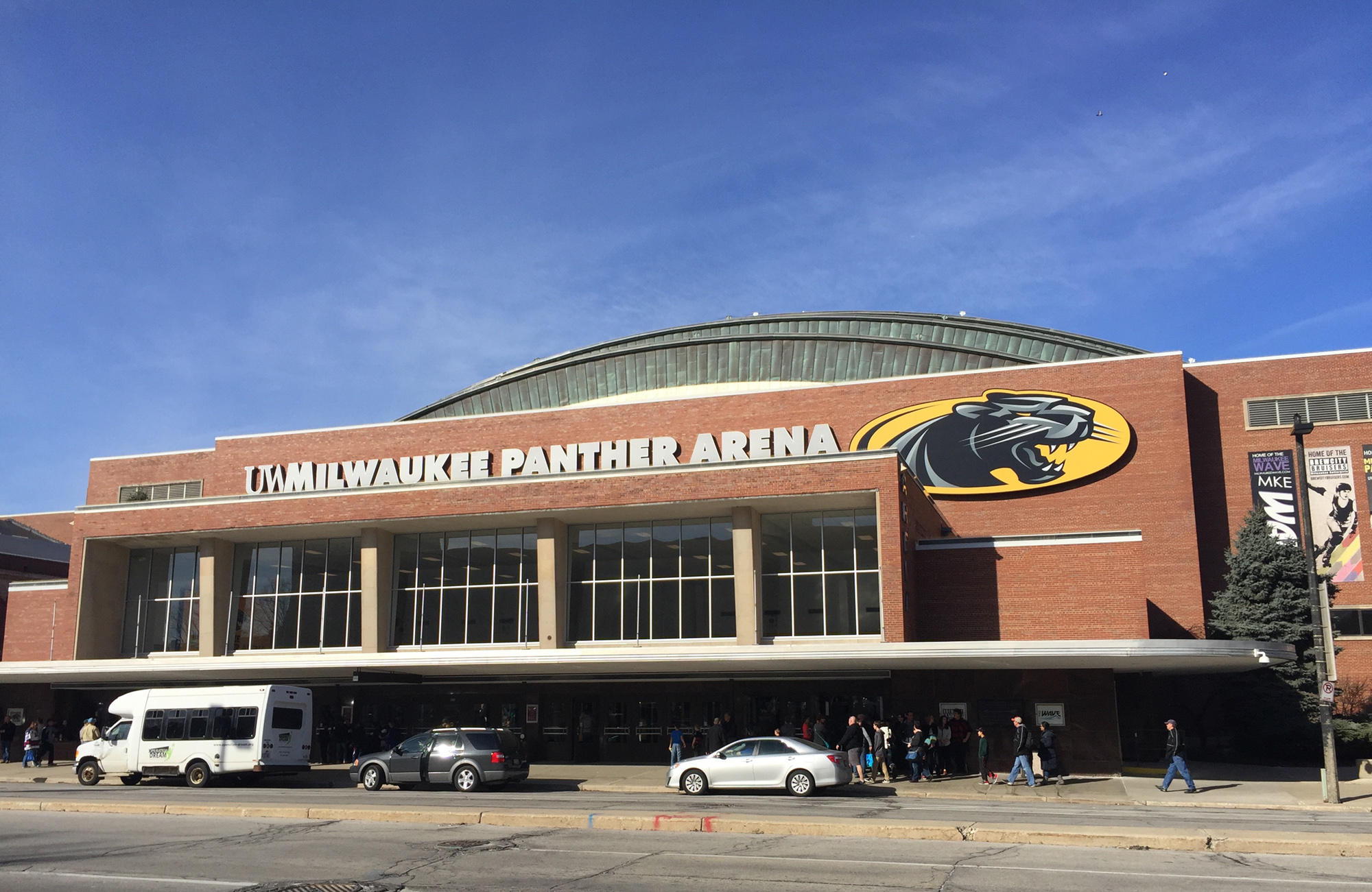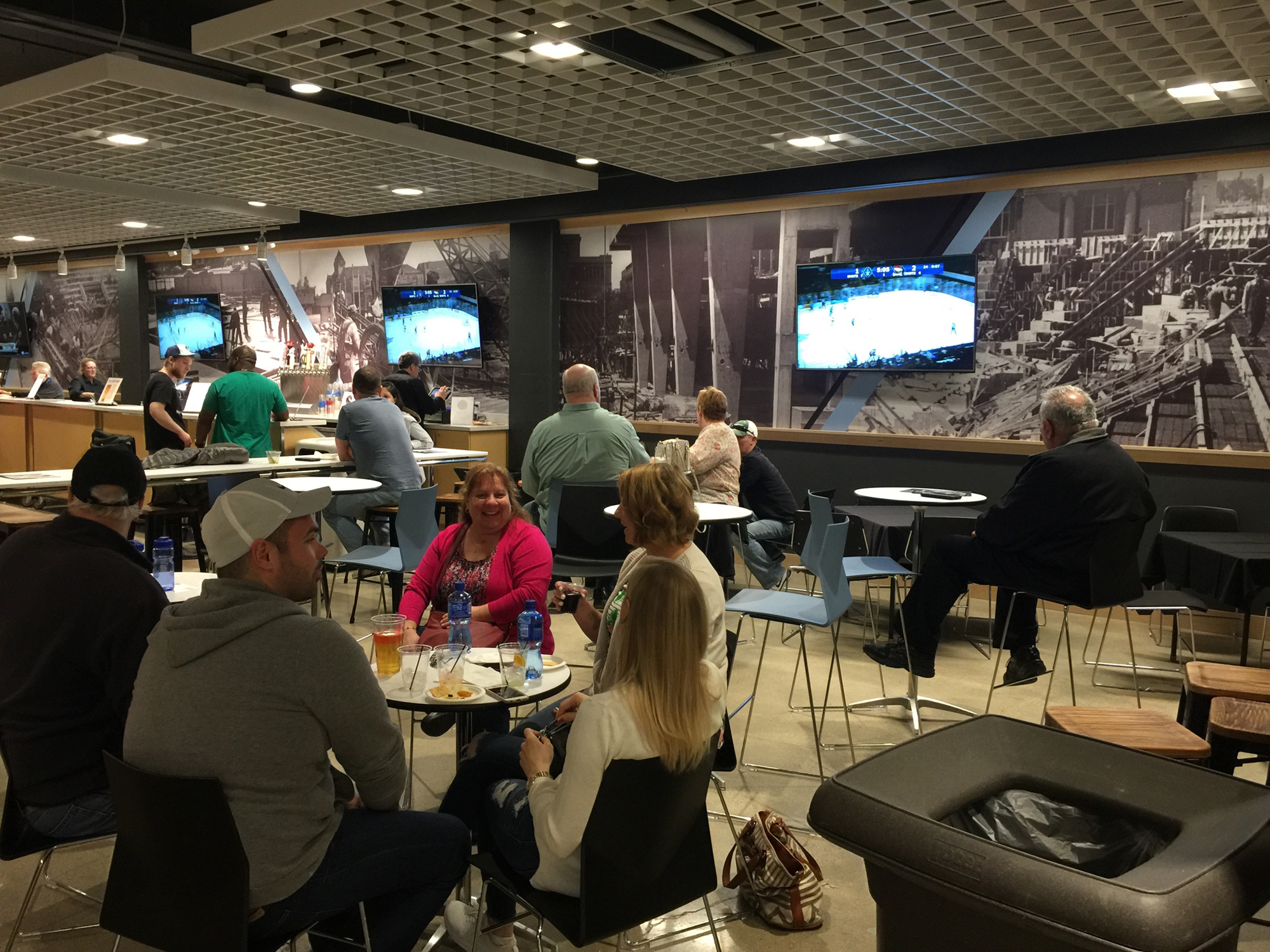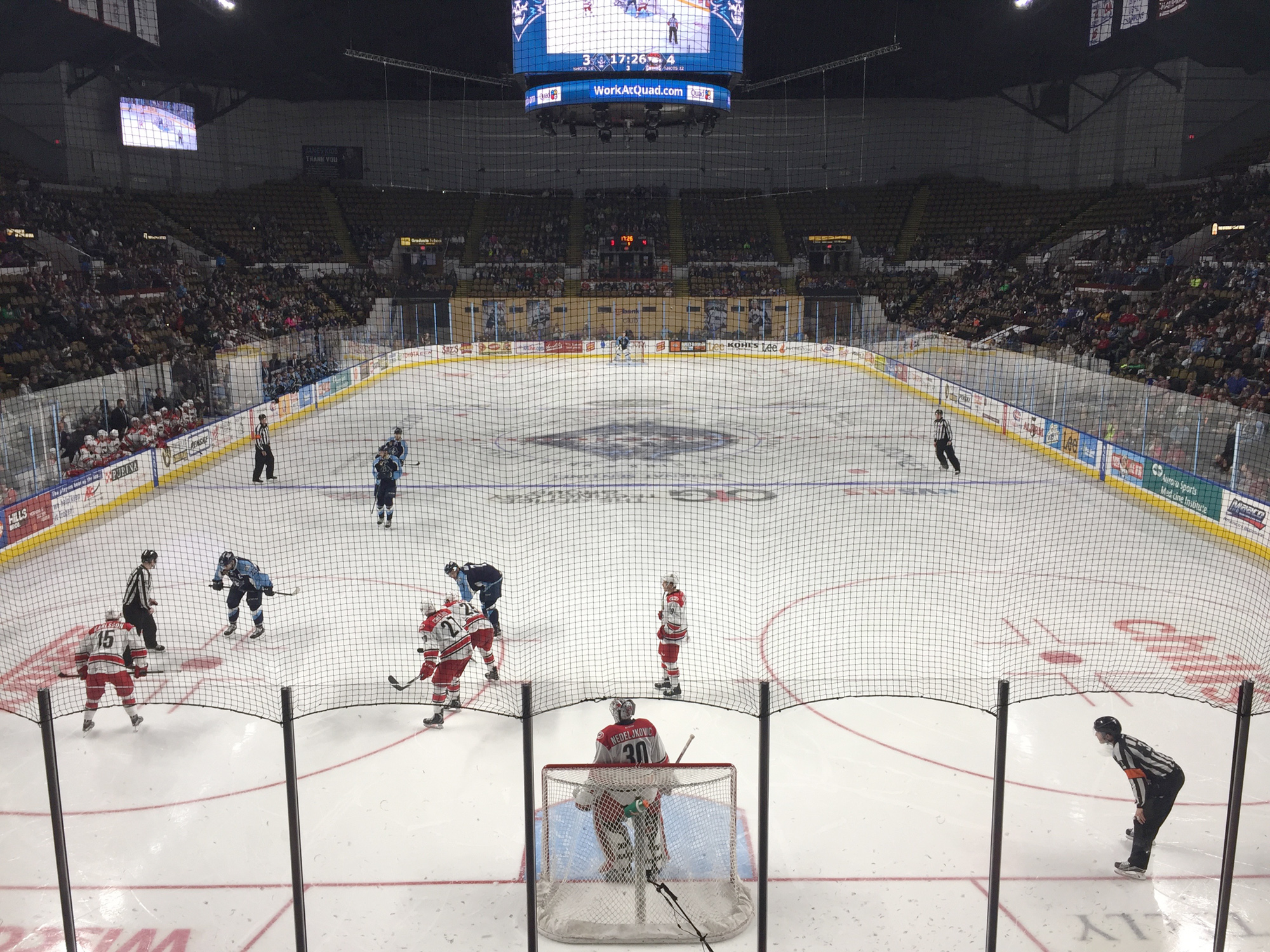It’s new life for a classic midcentury arena in Wisconsin, where the old Milwaukee Arena – now UW-Milwaukee Panther Arena – has been spruced up and now radiates a rediscovered charm thanks to improvements fueled by the Milwaukee Admirals (AHL) and the Wisconsin Center District.
The former home to the Milwaukee Bucks, Marquette University basketball and the old Milwaukee Hawks, UW-Milwaukee Panther Arena exudes a distinct, spare classicism on the exterior and Art Deco touches in the interior, most prominently in the curved lines of the concourse. Designed by the local architecture firm of Eschweiler & Eschweiler, the arena’s exterior has been largely unchanged since opening in 1950. And while the interior has seen some updates over the years, the basic bones of the arena are basically unchanged as well.
Until now. The Wisconsin Center District, which owns and operates Panther Arena, the next-door Milwaukee Theatre and the downtown convention center, had sold naming rights to University of Wisconsin-Milwaukee in 2014 in a deal that called for lots of signage and a three-stage replacement of arena seating.
But the real arena upgrades came when the Milwaukee Admirals, who had played previously at BMO Harris Bradley Center, committed to returning their previous home last year, beginning with the 2016-2017 season. The Admirals had played at Milwaukee Arena between 1970 and 1988, moving to the Bradley Center along with the Bucks. The 10-year lease (with a five-year option) called for the Admirals to pay $2 million for arena upgrades; the Wisconsin Center District would pay $4.3 million. The money wasn’t necessary spent on big things, but rather a serious of cost-effective upgrades that modernized the arena game-day operations but still managed to retain the essential charm of the arena.
Those upgrades included a new Admirals locker room (curved, no corners) and a new visitors’ locker room, the remaining seat replacements, new LED lights throughout, WiFi in the arena bowl, new dasherboards, new retractable risers, upgraded box offices, a team-store expansion, kitchen and concession upgrades, restroom upgrades (featuring lots of subway tiles, new flooring and new fixtures), renovated ticket lobby, new roof, and more. In short, some 16 months of work was done in one offseason, after the UW-Milwaukee season ended and the Admirals’ 2016 campaign began. These are not necessarily the most glamorous of upgrades, but they are essential.
According to Jon Greenberg, Admirals president, the move has been a smashing success. True, attendance is down from last season — 5,032 fans per game so far this season, compared to 6,169 fans per game in 2015-2016 and 5,809 fans per game in 2014-2015. The difference: at Panther Arena, the team has plenty of new revenue streams (group areas, concessions) it was denied at BMO Harris Bradley Center.
“It’s been a huge success for us,” Greenberg said. “We certainly have seen a big rise in revenues. And in terms of an important stat – percent of capacity – we’re way up as well.
“We’re now playing at 70 percent of capacity, as opposed to 33 percent at BMO Harris Center,” he added. “That makes a huge difference.”
With the move, the Admirals focused on specific improvements to Milwaukee Arena. This was a classic case of the bones of the facilities in great shape, with the entry and concourses still retaining that midcentury modern curvature and grace. Besides all the aforementioned upgrades, the Admirals installed three noteworthy group areas, all on ice level, as part of the lease.
First: an upscale U.S. Bank Club located in the north end of the arena, between the end wall and the glass. This would normally be dead space for hockey – it’s riser space for basketball – but the Admirals installed four tops, a dinner buffet and a bar in the space. It’s sold either as individual tickets ($65-$75, depending on the opponent) or for the entire space for groups.
At the other end of the rink: The South Goal Tap Room (shown above), open to all. Featuring open bar seating and TVs with game action, the tap room is adjacent to south-rink seats, and a $40 ticket ($45 for premium games) gets you a seat in section 101 or 131 and two drink tickets. There was a bar in that space during the Milwaukee Bucks era in the 1970s, according to Greenberg, and it certainly is a Sconnie space – Leinenkugel, Lakefront and Sprecher beers among the 12 on tap, and a classic cocktail menu that includes a Brandy Old Fashioned Sweet and Bloody Marys. Take a good look at the construction photos behind the bar: Hunzicker Construction, which built the arena in 1948-1950 and was involved in the recent renovations, supplied them.
And, finally, the Ads offer a group space that’s become fairly trendy in hockey circles: the space between the benches, formerly used by game officials and scorers, is now sold as the Ice Box. The space seats 12 and costs $750 or $1,000 (depending on the opponent), including $300 in concession cards.
But that great old atmosphere remains in an arena that has the right capacity — 9,652 – and enough homages to the past. Miller Park keyboardist Dean Rosco handles the Allen R311 theatre organ and is key to entertaining the crowd. Though the concessions have been upgraded, the concourse still has the feel of the original, as do the walkways to the upper levels. The main entrance makes a statement, restored to the same look fans would have seen when buying a ticket to see Bob Pettit in action.
Why are these links to the past so important? Because the old Milwaukee Arena was a big deal in the city’s cultural history. The new arena was key in landing the old Tri-Cities Blackhawks (playing out of Wharton Field House in Moline), an oft-on-the-move NBA franchise that spent four seasons in Milwaukee before moving to St. Louis for the 1955-1956 season and then eventually to Atlanta. Meanwhile, it would take Milwaukee over a decade to bring the NBA back to town, with Milwaukee Professional Sports and Services awarded an expansion franchise in 1968. The Bucks would play out of Milwaukee Arena until BMO Harris Bradley Center opened in 1988. The team would best be known for two glory periods: the first, 1970 – 1975, when Kareem Abdul-Jabbar, Bob Dandridge and Oscar Robertson fueled a run to an NBA championship in the 1970-1971 season, and the second, 1977-1984, when Don Nelson, Sidney Moncrief, Brian Winters, Junior Bridgeman led the Bucks to five consecutive divisional championships. The arena was best known as the MECCA (Milwaukee Exposition, Convention Center and Arena) during this time, with a brightly colored Robert Indiana basketball court.
But not all is nostalgia: The high-def center-hung scoreboard provides a crystal-clear view of the action and entertains the crowd during the stoppage of play. The concessions from Levy Restaurants offer more than just popcorn and hot dogs, drawing in fans with an abundance of craft beers, local food specialties and offerings from the likes of Saz’s, a Milwaukee barbeque institution.
And the upgrades will continue during the offseason. Most interesting in the short term: the vinyl flooring on the concourse could be removed to expose the terrazzo floor underneath, but a full restoration will depend on the condition. Longer term, the entire area around the arena will change. BMO Harris Bradley Center will be going away in coming years, replaced by a new Milwaukee Bucks arena, a new entertainment district and other development.
This article first appeared in the Arena Digest weekly newsletter. Are you a subscriber? Sign up here for a free subscription!







